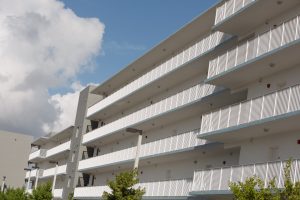We’ve all had the experience of visiting a friend or family member who wants to show off their new house.
The bigger and more palatial the house, the more impressive, of course, and at some point there’s usually a moment where the host takes you out to a balcony with a gorgeous view of the property, and perhaps even miles of countryside in the distance, and you are suitably impressed (remembering, of course, to look out and say, “What a gorgeous view!”).
Have you ever stepped out onto a balcony at times like this and found that there was no railing?
That there was absolutely nothing to keep you from stepping off into space and perhaps hovering there for a moment like Wile E. Coyote when he runs off the edge of a cliff, then plunging straight down?
Yikes!!!
Well if you have, you should have immediately dialed up your brother-in-law the lawyer, because it would be only a matter of time before someone fell off that balcony and needed an accident lawyer pronto.
It’s a fact of life that any residential or commercial building these days is going to have a sturdy railing installed on every porch, balcony, and staircase for the protection of visitors (and the protection of its owner from lawsuits).
There are building codes that mandate the installation of railings, and every building has to conform to the codes when inspectors arrive to look it over, or it won’t pass muster.
Even though every municipality enforces building codes, most of them do not have a team of code writers squirreled away in a back office writing regulations. They use codes that are written by various national and international code bodies, like the International Code Council, the National Fire Protection Association, and the Occupational Safety and Health Administration (OSHA). These codes can be very specific about what is acceptable, and anyone involved in the building trade has to be familiar with them.
At Railco, we work with building code guidelines every day, and since our clients are builders and developers, we have to be familiar with codes that apply to many different municipalities. Let’s take a look at the generally accepted code for railings.
For new construction of guard rails, the minimum height is 42 inches from the finished floor.
There is also something called the Sphere Rule, which means that there can be no opening in the rail large enough to pass a four inch sphere through.
This rule is expanded to six inches in the triangular area between the bottom rail and the stair tread.
In addition, there is a generally accepted “Beer Bottle Rule” in which there is a two inch gap between the bottom channel of a rail and the floor so a beer bottle won’t roll off a balcony. We’re not sure if this rule was specifically created for college frat houses, but it’s probably saved countless frat boys from getting conked on the head with beer bottles.
Guard rails have load requirements of 200 pounds of concentrated load (To hold the larger members of the fraternity when they decide to do a headstand on the guard rail?) and 50 pounds per foot of uniform load.
Handrails are different from guard rails, and they have different requirements. The generally accepted code for handrail height from the floor is between 34 and 38 inches at the top of the rail. Also, handrails must extend down the horizontal distance of a stair tread at the bottom, and twelve inches at the top.
These are just a few of the standard codes for railings. Their main purpose is safety, and although no railing can protect a person against poor judgment (not to pick on fraternity bros, but you can imagine that there are situations where judgment is impaired just a bit), a well-made, professionally installed railing can keep the majority of accidents from happening.
One regulation that was designed to protect children is the “Ladder Effect”. This first appeared in the Building Officials Code Administrators International (BOCA) National Building Code in 1993.
It stated that: “Required guards shall not be constructed with horizontal rails or other ornamental patterns that result in a ladder effect.” It was meant to keep small children from using the horizontal rails or ornaments like steps so they could climb to the top rail.
Although it has since been dropped as a requirement because no hard evidence was found to prove there was an epidemic of injuries to small children from climbing, some municipalities still enforce it.
As you can see, there are many things to consider when installing railings. Some codes have regulations for how far a rail can protrude from the wall, the width between horizontal rails on a ramp, the diameter of the rails, and the bracket clearance, to name just a few.
At Railco, we realize that our customers have a big job just to keep track of all the codes they need to comply with (and railings are only one part of it!), so we make it our mission to know and follow the codes, just to make things easier for them.
Our teams can give expert advice and guidance in all areas of railing manufacturing and installation to the professional engineers, architects, and contractors we work with.
We’ve been in business for over 25 years and we’ve built an impressive portfolio of work throughout South Florida and the Caribbean. Some of the jewels in our crown include luxury resorts in Turks and Caicos and Grand Cayman.
These resorts include some of our most creative work, from railings and guardrails to fences and gates—and some stunning architectural structures. Every piece is engineered to perfection, expertly crafted, and installed with the greatest attention to safety and security.
We consider ourselves a key player in the construction team, and our railing and fencing experts work closely with the builder and architect to craft the perfect solution for the job at hand.
Our expert engineers are always available to help our customers create the best possible design for any space. We give personal attention to every project — all pieces are fabricated in-house under the careful supervision of owner Lenny Fagundo. Before anything goes out the door to the customer, our Aesthetic Department verifies that it complies with all building codes and meets the highest level of quality.
Building codes exist for the safety of everyone who visits a building, in whatever capacity.
Safety is always the first priority, and that’s why you’ll probably never get a tour of a finished house that doesn’t have a railing on a balcony. It may be funny to see a cartoon character fall off a ledge, but nobody wants to see that happen in real life.
At Railco, we’re grateful that the codes exist, but we also know that our customers need help in complying with them in a cost-effective manner that also takes into account the beauty of the structure.





